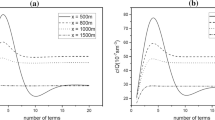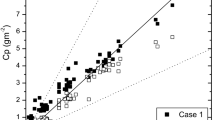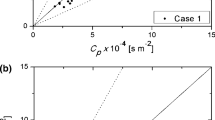Abstract
This study aims to investigate the potential of fractional derivatives in the mathematical modelling of the dispersion of air pollutants. For this purpose, an analytical solution of the fractional two-dimensional advection–diffusion equation by combining generalized integral Laplace transform technique (GILTT) and conformable derivatives methods was proposed. Although the use of the conformable derivatives loses the non-local character contained in the fractional derivatives, fractional parameters remain in the solution. Thus, this procedure allows considering the anomalous behaviour in the diffusion process, resulting in a new methodology here called the \(\alpha\)-GILTT method. The concentrations calculated with the model were compared with ground-level crosswind-integrated concentrations data from the Copenhagen and Prairie Grass experiments. The statistical indices showed the best results for the moderately unstable Copenhagen experiment under conditions of low fractionality (values close to unity). However, for the strongly convective Prairie Grass experiment, the results showed greater dependence on the fractional parameters (integer-order: NMSE = 0.90, COR = 0.81, FAT2 = 0.63; non-integer order: NMSE = 0.56, COR = 0.89, FAT2 = 0.84). The results suggest that fractional parameters are dependent on atmospheric stability and open a new direction to improve the knowledge of the atmospheric pollutant dispersion processes.





Similar content being viewed by others
Data Availability
The datasets generated during and/or analysed during the current study are available from the corresponding author on reasonable request.
References
Abdelhakim, A. A. (2019). The Flaw in the conformable calculus: It is conformable because it is not fractional. Fractional Calculus and Applied Analysis, 22(2), 242–254.
Abdelhakim, A. A., & Machado, J. A. T. (2019). A critical analysis of the conformable derivative. Nonlinear Dynamics, 95, 3063–3073.
Abdeljawad, T. (2015). On conformable fractional calculus. Journal of Computational and Applied Mathematics, 279, 57–66.
Acioli, P. S., Xavier, F. A., & Moreira, D. M. (2019). Mathematical model using fractional derivatives applied to the dispersion of pollutants in the planetary boundary layer. Boundary-Layer Meteorology, 170(2), 285–304.
Adomian, G. (1994). Solving frontier problem of physics: The decomposition method (p. 354). Springer Netherlands.
Anderson, D. R., & Ulness, D. J. (2015). Properties of the Katugampola fractional derivative with potential application in quantum mechanics. Journal of Mathematical Physics, 56(6), 063502.
Anderson, D. R., Camrud, E., & Ulness, D. J. (2019). On the nature of the conformable derivative and its applications to physics. Journal of Fractional Calculus and Applications, 10(2), 92–135.
Atangana, A. (2015). Derivative with a new parameter: Theory, methods and applications. Academic Press.
Avci, D., Eroğlu, B. B. İ, & Özdemir, N. (2017). The Dirichlet problem of a conformable advection-diffusion equation. Thermal Science, 21(1), 9–18.
Babakhani, A., & Daftardar-Gejji, V. (2002). On calculus of local fractional derivatives. Journal of Mathematical Analysis and Applications, 270(1), 66–79.
Barad, M. L. (1958). Project prairie grass, a field program in diffusion. Volume 1 (no. Grp-59-vol-1). Air Force Cambridge Res. Labs Hanscom AFB MA. https://doi.org/10.1016/0022-460X(71)90105-2
Buske, D., Vilhena, M. T., Moreira, D. M., & Tirabassi, T. (2007a). An analytical solution of the advection-diffusion equation considering non-local turbulence closure. Environmental Fluid Mechanics, 7(1), 43–54.
Buske, D., Vilhena, M. T., Moreira, D. M., & Tirabassi, T. (2007b). Simulation of pollutant dispersion for low wind conditions in stable and convective planetary boundary layer. Atmospheric Environment, 41(26), 5496–5501.
Chen, Y., Yan, Y., & Zhang, K. (2010). On the local fractional derivative. Journal of Mathematical Analysis and Applications, 362(1), 17–33.
Chung, W. S. (2015). Fractional Newton mechanics with conformable fractional derivative. Journal of Computational and Applied Mathematics, 290, 150–158.
Crank, J. (1979). The mathematics of diffusion. Oxford University Press.
Çenesiz, Y., Kurt, A., & Nane, E. (2017). Stochastic solutions of conformable fractional Cauchy problems. Statistics & Probability Letters, 124, 126–131.
Costa, C. P., Vilhena, M. T., Moreira, D. M., & Tirabassi, T. (2006). Semi-analytical solution of the steady three-dimensional advection-diffusion equation in the planetary boundary layer. Atmospheric Environment, 40(29), 5659–5669.
Degrazia, G. A., Campos Velho, H. F., & Carvalho, J. C. (1997). Nonlocal exchange coefficients for the convective boundary layer derived from spectral properties. Contributions to Atmospheric Physics, 70, 57–64.
Degrazia, G. A., Moreira, D. M., & Vilhena, M. T. (2001). Derivation of an eddy diffusivity depending on source distance for a vertically inhomogeneous turbulence in a convective boundary layer. Journal of Applied Meteorology, 40, 1233–1240.
Ghorbani, A. (2008). Toward a new analytical method for solving nonlinear fractional differential equations. Computer Methods in Applied Mechanics and Engineering, 197(49–50), 4173–4179.
Gómez-Aguilar, J. F., Miranda-Hernández, M., López-López, M. G., Alvarado-Martínez, V. M., & Baleanu, D. (2016). Modelling and simulation of the fractional space-time diffusion equation. Communications in Nonlinear Science and Numerical Simulation, 30(1–3), 115–127.
Gryning, S. E., & Lyck, E. (1984). Atmospheric dispersion from elevated sources in an urban area: Comparison between tracer experiments and model calculations. Journal of Applied Meteorology and Climatology, 23(4), 651–660.
Hanna, S. R. (1989). Confidence limits for air quality model evaluations, as estimated by bootstrap and jackknife resampling methods. Atmospheric Environment, 23(6), 1385–1398.
Iyiola, O. S., Tasbozan, O., Kurt, A., & Çenesiz, Y. (2017). On the analytical solutions of the system of conformable time-fractional Robertson equations with 1-D diffusion. Chaos Solitons & Fractals, 94, 1–7.
Khalil, R., Al Horani, M., Yousef, A., & Sababheh, M. (2014). A new definition of fractional derivative. Journal of Computational and Applied Mathematics, 264, 65–70.
Kumar, P., & Sharan, M. (2010). An analytical model for dispersion of pollutants from a continuous source in the atmospheric boundary layer. Proceedings of the Royal Society a: Mathematical, Physical and Engineering Sciences, 466(2114), 383–406.
Metzler, R., & Klafter, J. (2000). The random walk’s guide to anomalous diffusion: A fractional dynamics approach. Physics Reports, 339(1), 1–77.
Metzler, R., & Klafter, J. (2004). The restaurant at the end of the random walk: Recent developments in the description of anomalous transport by fractional dynamics. Journal of Physics a: Mathematical and General, 37(31), R161.
Moreira, D. M., Rizza, U., Degrazia, G. A., Mangia, C., & Tirabassi, T. (1998). An analytical air pollution model: Development and evaluation. Contributions to Atmospheric Physics, 71(3), 315–320.
Moreira, D. M., Vilhena, M. T., Carvalho, J. C., & Degrazia, G. A. (2005a). Analytical solution of the advection-diffusion equation with nonlocal closure of the turbulent diffusion. Environmental Modelling & Software, 20(10), 1347–1351.
Moreira, D. M., Vilhena, M. T., Tirabassi, T., Buske, D., & Cotta, R. (2005b). Near-source atmospheric pollutant dispersion using the new GILTT method. Atmospheric Environment, 39(34), 6289–6294.
Moreira, D. M., Rizza, U., Vilhena, M. T., & Goulart, A. (2005c). Semi-analytical model for pollution dispersion in the planetary boundary layer. Atmospheric Environment, 39(14), 2673–2681.
Moreira, D. M., Vilhena, M. T., Buske, D., & Tirabassi, T. (2006). The GILTT solution of the advection-diffusion equation for an inhomogeneous and nonstationary PBL. Atmospheric Environment, 40(17), 3186–3194.
Moreira, D. M., Vilhena, M. T., Buske, D., & Tirabassi, T. (2009). The state-of-art of the GILTT method to simulate pollutant dispersion in the atmosphere. Atmospheric Research, 92(1), 1–17.
Moreira, D. M., & Vilhena, M. T. (2009). Air pollution and turbulence: Modelling and applications. CRC Press.
Moreira, D. M., Moraes, A. C., Goulart, A. G., & Albuquerque, T. T. (2014). A contribution to solve the atmospheric diffusion equation with eddy diffusivity depending on source distance. Atmospheric Environment, 83, 254–259.
Moreira, D. M., & Moret, M. (2018). A new direction in the atmospheric pollutant dispersion inside the planetary boundary layer. Journal of Applied Meteorology and Climatology, 57(1), 185–192.
Moreira, D. M., & Santos, C. A. G. (2019). New approach to handle gas-particle transformation in air pollution modelling using fractional derivatives. Atmospheric Pollution Research, 10(5), 1577–1587.
Moreira, D. M., Xavier, P. H. F., Palmeira, A. S., & Nascimento, E. G. S. (2019). New approach to solving the atmospheric pollutant dispersion equation using fractional derivatives. International Journal of Heat and Mass Transfer, 144, 118667.
Nieuwstadt, F. T. M. (1980). Application of mixed-layer similarity to the observed dispersion from a ground-level source. Journal of Applied Meteorology and Climatology, 19(2), 157–162.
Palmeira, A., Xavier, P. H., & Moreira, D. M. (2020). Simulation of atmospheric pollutant dispersion considering a bi-flux process and fractional derivative. Atmos. Polut. Res., 11(1), 57–66.
Panofsky, H. A. & Dutton, J. A (1984). Atmospheric turbulence: Models and methods for engineering applications. Wiley.
Perez-Guerrero, J. S., Pimentel, L. C. G., Ulke, A. G., Oliveira-Junior, J. F., & Heilbron Filho, P. F. L. (2012). A unified analytical solution of the steady-state atmospheric diffusion equation. Atmospheric Environment, 55, 201–212.
Pimentel, L. C. G., Pérez Guerrero, J. S., Ulke, A. G., Duda, F. P., & Heilbron Filho, P. F. L. (2014). Assessment of the unified analytical solution of the steady-state atmospheric diffusion equationfor stable conditions. Proceedings of the Royal Society A: Mathematical, Physical and Engineering Sciences, 470(2167), 20140021.
Richardson, L. F. (1926). Atmospheric diffusion shown on a distance-neighbour graph. Proceedings of the Royal Society of London Series A Containing Papers of a Mathematical and Physical Character, 110(756), 709–737.
Segatto, CF., Vilhena, M. T. (1999). The state-of-the-art the LTSN method, Mathematics and Computation. In Proccedings of the International Conference in Reactor Physics and Environmental Analysis in Nuclear Applications, Madrid, 2, 1618–1631.
Tarasov, V. E. (2018). No nonlocality. No fractional derivative. Communications in Nonlinear Science and Numerical Simulation, 62, 157–163.
Tirabassi, T., Buske, D., Moreira, D. M., & Vilhena, M. T. (2008). A two-dimensional solution of the advection-diffusion equation with dry deposition to the ground. Journal of Applied Meteorology and Climatology, 47(8), 2096–2104.
Venkatram, A., & Wyngaard, J. C. (1988). Lectures on air pollution modelling. American Meteorological Society.
Vilhena, M. T., Costa, C. P., Moreira, D. M., & Tirabassi, T. (2008). A semi-analytical solution for the three-dimensional advection-diffusion equation considering non-local turbulence closure. Atmospheric Research, 90(1), 63–69.
West, B. J., Bologna, M., & Grigolini, P. (2003). Physics of fractal operators. Springer.
Willis, G. E., & Deardorff, J. W. (1976). A laboratory model of diffusion into the convective planetary boundary layer. Quarterly Journal of the Royal Meteorological Society, 102(432), 427–445.
Wortmann, S., Vilhena, M. T., Moreira, D. M., & Buske, D. (2005). A new analytical approach to simulate the pollutant dispersion in the PBL. Atmospheric Environment, 39(12), 2171–2178.
Zhokh, A. A., Trypolskyi, A. I., & Strizhak, P. E. (2017). Asymptotic Green’s functions for time-fractional diffusion equation and their application for anomalous diffusion problem. Physica a: Statistical Mechanics and Its Applications, 475, 77–81.
Acknowledgements
We are thankful for the support of SENAI CIMATEC and CNPq.
Author information
Authors and Affiliations
Corresponding author
Ethics declarations
Competing Interests
The authors declare no competing interests.
Additional information
Publisher's Note
Springer Nature remains neutral with regard to jurisdictional claims in published maps and institutional affiliations.
Rights and permissions
Springer Nature or its licensor holds exclusive rights to this article under a publishing agreement with the author(s) or other rightsholder(s); author self-archiving of the accepted manuscript version of this article is solely governed by the terms of such publishing agreement and applicable law.
About this article
Cite this article
Santos Soledade, A.L., Martins Moreira, D. Fractional Atmospheric Pollutant Dispersion Equation in a Vertically Inhomogeneous Planetary Boundary Layer: an Analytical Solution Using Conformable Derivatives. Water Air Soil Pollut 233, 395 (2022). https://doi.org/10.1007/s11270-022-05864-7
Received:
Accepted:
Published:
DOI: https://doi.org/10.1007/s11270-022-05864-7




